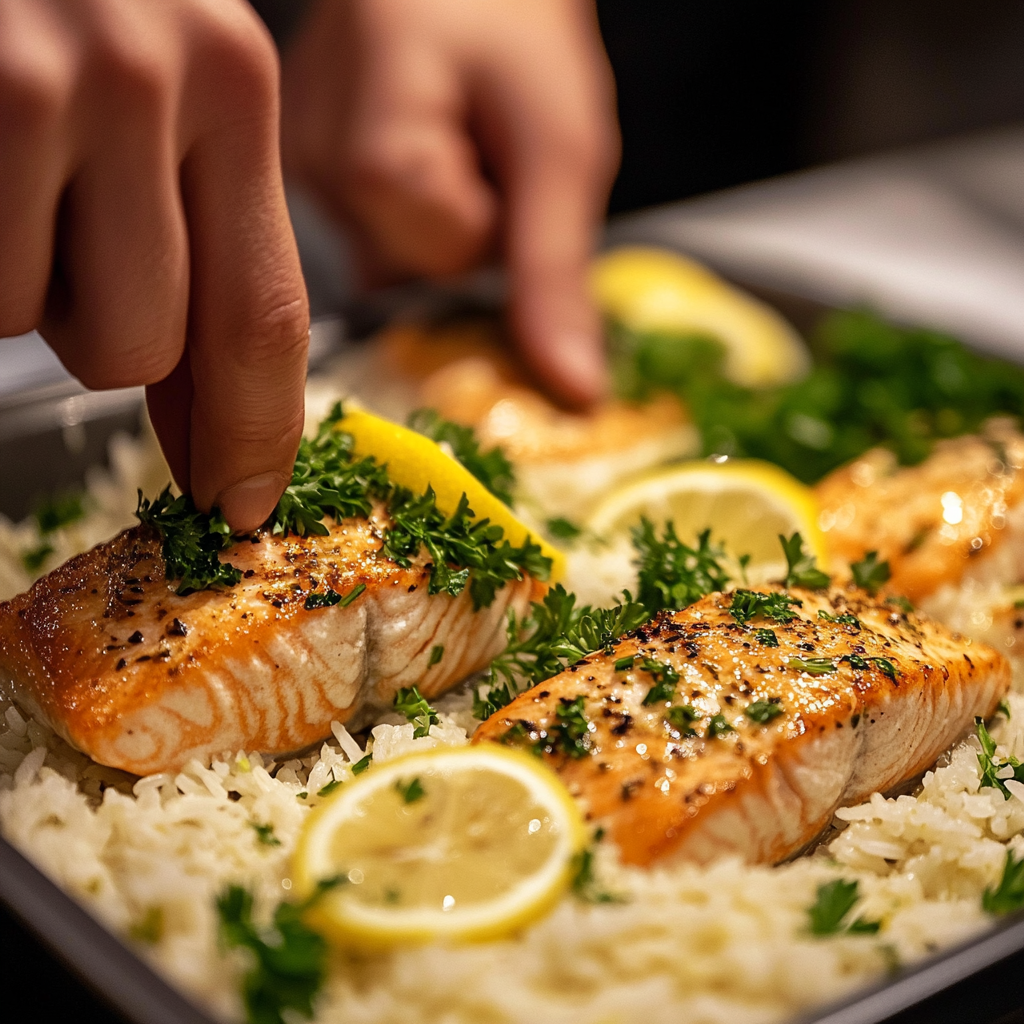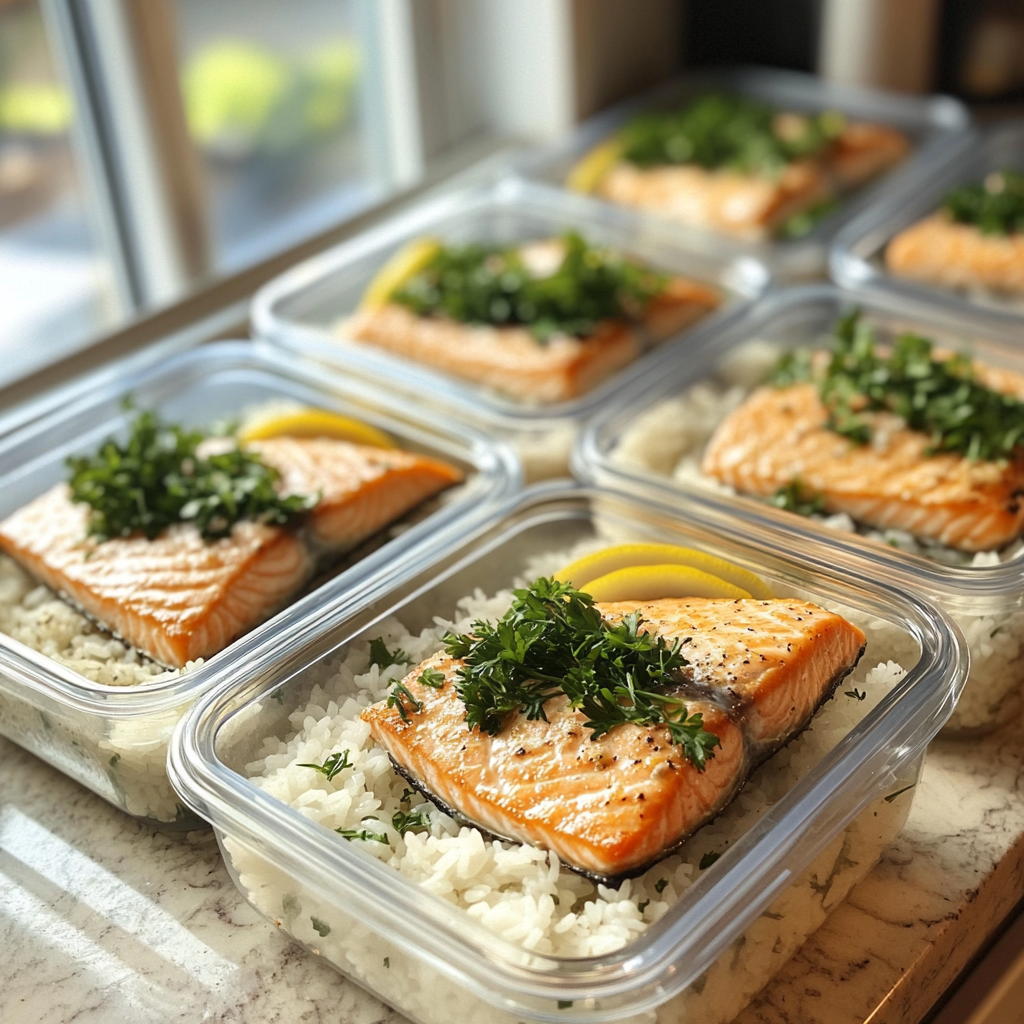Introduction
This salmon and rice recipe is a perfect match made in heaven, offering a balanced, nutritious, and delicious meal that’s easy to prepare. Whether you’re cooking a quick weeknight dinner or hosting a weekend gathering, this dish provides all the necessary ingredients for a wholesome and tasty meal. Salmon is a well-loved fish for its rich flavor and health benefits, while rice offers a simple and versatile base that can be customized to suit a variety of tastes.
In this guide, you’ll learn how to make a mouthwatering salmon and rice recipe, explore the health benefits of its key ingredients, and discover a variety of ways to modify the dish to your liking.
Ingredients for the Perfect Salmon and Rice Recipe
Here’s everything you need to create this flavorful and easy salmon and rice recipe:
- 4 salmon fillets (around 6 oz each)
- 1 cup jasmine, basmati, or brown rice (you can also try wild rice for extra flavor)
- 2 tablespoons olive oil
- 2 cloves garlic, minced
- 1 lemon, thinly sliced
- Salt and pepper to taste
- Fresh parsley or cilantro for garnish
- Optional: soy sauce, teriyaki sauce, or a lemon-butter sauce for drizzling
Optional Sides:
- Steamed or roasted vegetables (broccoli, asparagus, carrots)
- Fresh mixed salad with a light vinaigrette
- Avocado slices or guacamole (try our guacamole recipe)

Step-by-Step Instructions for Cooking the Ultimate Salmon and Rice Recipe
1. Cook the Rice
Begin by preparing your rice. Whether you’re using jasmine, basmati, or brown rice, follow the package instructions for the best results. For extra flavor, cook the rice in vegetable or chicken broth instead of water. Rinsing the rice in cold water beforehand will remove excess starch, ensuring fluffier grains.
- Brown Rice Option: If you’re using brown rice for a healthier twist, keep in mind that it takes longer to cook (about 40 minutes) than white rice (15-20 minutes). A rice cooker can also help save time.
- Quinoa Substitution: Looking for more protein? Substitute the rice with quinoa. It takes about 15 minutes to cook and is packed with fiber and nutrients.
2. Prepare the Salmon Fillets
While the rice cooks, pat the salmon fillets dry with paper towels to remove any moisture. Season the salmon fillets generously with salt, pepper, and minced garlic. If you have extra time, marinate the salmon in a mix of olive oil, lemon juice, and fresh herbs (like dill or parsley) for at least 30 minutes for an added depth of flavor.
3. Sear the Salmon
Heat 2 tablespoons of olive oil in a large skillet over medium-high heat. Once the oil is hot, place the salmon fillets skin-side down in the skillet. Cook for about 4-5 minutes, allowing the skin to crisp up nicely.
Flip the salmon fillets and cook for another 3-4 minutes, or until the fish is cooked through and flakes easily with a fork. The internal temperature of the salmon should reach 145°F (63°C) at the thickest part. For a citrusy touch, add lemon slices to the pan during the final minute of cooking.
4. Serve and Garnish
Spoon a generous portion of cooked rice onto each plate and top it with a perfectly seared salmon fillet. Garnish with freshly chopped parsley or cilantro, and if desired, drizzle soy sauce, teriyaki sauce, or lemon-butter sauce over the dish. Pair your salmon and rice recipe with a side of steamed vegetables or a crisp salad for a well-rounded meal.

The Health Benefits of Salmon and Rice
This salmon and rice recipe isn’t just delicious—it’s packed with health benefits that make it an excellent choice for those looking to maintain a balanced diet.
Salmon: A Nutritional Powerhouse
Salmon is one of the best sources of omega-3 fatty acids, which are essential for promoting heart health, reducing inflammation, and supporting brain function. Additionally, salmon is rich in high-quality protein, vitamins, and minerals, making it an ideal choice for a nutritious meal.
Key benefits of salmon include:
- Omega-3 Fatty Acids: Known for supporting heart health, reducing inflammation, and improving cognitive function.
- High-Quality Protein: Salmon is packed with all essential amino acids, making it a perfect post-workout meal for muscle repair and growth.
- Vitamin D: Essential for bone health and immune function, salmon is a great source of this important nutrient.
- B Vitamins: These vitamins help boost energy levels and improve brain function.
Rice: Energy and Versatility
Rice, especially brown or wild rice, is a great source of complex carbohydrates that provide long-lasting energy. Depending on the type you choose, rice can offer a range of health benefits:
- Brown Rice: High in fiber, promoting digestive health and helping regulate blood sugar levels. It’s also a good source of magnesium and selenium.
- White Rice: Easier to digest, making it a suitable option for those with sensitive stomachs.
- Wild Rice: Packed with antioxidants and fiber, wild rice offers a nutty flavor and adds extra nutrition to your meal.
Together, salmon and rice create a meal that provides healthy fats, lean protein, and sustained energy.
Tips for Perfecting Your Salmon and Rice Recipe
Cooking salmon and rice is simple, but these tips will help ensure that your dish turns out perfectly every time.
Choose Fresh Salmon
When buying salmon, opt for wild-caught varieties whenever possible, as they are generally more nutrient-dense and flavorful than farm-raised salmon. Look for fillets that are bright in color with firm flesh and no fishy smell.
Avoid Overcooking the Salmon
Salmon is best when it’s cooked just until it flakes easily with a fork. Overcooking can lead to a dry, less flavorful fillet. To ensure perfectly cooked salmon, use a meat thermometer to check for an internal temperature of 145°F (63°C).
Enhance the Flavor with Marinades
While simple seasoning works well, marinating the salmon for at least 30 minutes in olive oil, lemon juice, garlic, and herbs can enhance its flavor. For a sweet and savory twist, try a soy-based marinade with honey and ginger.
Pair with Vegetables and Sides
Salmon and rice make a great foundation for a meal, but adding a variety of vegetables and side dishes will make it even more enjoyable. Roasted or steamed vegetables like broccoli, asparagus, and carrots pair perfectly with the dish.
Variations on the Salmon and Rice Recipe
This salmon and rice recipe is incredibly versatile, and there are countless ways to customize it based on your preferences or dietary needs. Here are some ideas:
Mediterranean Salmon and Rice
For a Mediterranean twist, season the salmon with oregano, thyme, and lemon zest. Serve over rice pilaf made with olive oil, garlic, and onions. Add toasted pine nuts and raisins for a touch of sweetness, and garnish with fresh parsley.
Asian-Inspired Salmon and Rice
To add an Asian flair to your salmon and rice, marinate the salmon in a mixture of soy sauce, garlic, ginger, and honey. Serve over jasmine rice with a drizzle of teriyaki sauce and a sprinkle of sesame seeds. You can also serve this with sautéed bok choy or steamed edamame for extra nutrients.
Spicy Cajun Salmon and Rice
If you enjoy bold flavors, try a Cajun-inspired version of this recipe. Season the salmon with a blend of Cajun spices like paprika, cayenne, and garlic powder. Serve over rice cooked with bell peppers and onions for a colorful and flavorful dish.
Coconut Rice with Salmon
For a tropical variation, cook your rice in coconut milk for a creamy, fragrant base. The sweetness of the coconut pairs beautifully with the savory flavor of the salmon. Garnish with toasted coconut flakes and fresh lime wedges for a vibrant, island-inspired meal.
Meal Prep and Storage Tips
This salmon and rice recipe is great for meal prep, making it easy to enjoy a healthy meal throughout the week.

- Meal Prep: Cook the salmon and rice as directed and store in individual meal prep containers. You can keep these in the fridge for up to 3 days or freeze them for up to 1 month.
- Reheating: When reheating, use the microwave for 1-2 minutes or reheat in a skillet for a few minutes to retain the texture and flavor. If reheating from frozen, let the meal thaw overnight in the fridge.
FAQs
How long should I cook the salmon?
Salmon typically cooks in 8-10 minutes, depending on the thickness of the fillet. Make sure to flip the fillet halfway through for even cooking.
Can I use other grains instead of rice?
Yes! You can substitute rice with grains like quinoa, couscous, or even cauliflower rice for a low-carb option.
What’s the best type of salmon to use?
Wild-caught salmon is generally more flavorful and nutrient-rich than farm-raised salmon, but either can work in this recipe. Sockeye and Coho are popular wild varieties.
Conclusion
This salmon and rice recipe is a delicious, nutritious, and easy-to-prepare dish that can be customized to suit any taste or occasion. With its rich flavors, high-quality ingredients, and numerous health benefits, this meal is sure to become a regular staple in your kitchen. Try different variations and sides to keep things interesting, and explore more salmon recipes for additional inspiration

